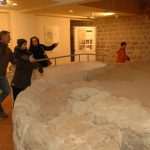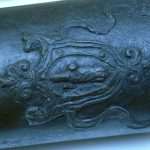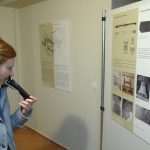The first caster of cannons was recorded in Dubrovnik in 1351, and the forts in the city were armed with bombards in 1358. The famous caster of cannons and bells, Ivan Krstitelj Rabljanin (John Baptist of Rab, born in Rab c. 1475, died in Dubrovnik, 1540) had his foundry in Rab but was commissioned in Dubrovnik in 1504, and officially became its citizen in 1509. His work was highly appreciated and in his workshop in Fort Revelin he cast his falconets, bombards and cannons for ships. The city commissioned him to cast ten cannons, none of them existing in Dubrovnik any longer. The cannons that came out of his foundry were made for different parts of Dubrovnik but were also sold in Southern Italy and Spain. They were famous in the world back then, while today there are only a few bells and a street bearing his name left after the famous craftsman.
His master-piece was cast in 1537 and named Gušter (the Lizard) after the custom that gave cannons the names of animals or fantastic creatures. It was located on Fort Lovrjenac (Fort St Lawrence) and contained the Latin inscription that freely translated comes to: “AD 1537 / If the omnipotent Jupiter decides to destroy / cruel humankind, my strength / would exert, more than Jupiter’s, / fierce force, skilfully created / by Baptist’s hand. / Opus of Baptist of Rab / On Fort Lovrjenac.
When the French arrived in 1806, they registered 133 bronze cannons in Dubrovnik, but they also introduced the practice of recasting larger bronze and iron cannons that was taken over by the Austrians who came in 1814 so that some cannons were transported to Vienna, while a certain number remained missing. The tradition says that when the Austrians were removing cannons from Fort Lovrjenac, Gušter was too long to be taken out through the fort doors so they tried to lower it down the walls and rocks of the fort but it fell into the deep sand on the bottom of the sea. In the end of the 19th century, it was said that when the sea was calm the cannon could have been seen down there. Despite knowing the approximate location, all the attempts to recover it have failed.
Today, the exhibition entitled Revelin: Archaeological Research/Spatial Development/Foundry shows the historical and spatial development of Fort Revelin from the 13th century to the renovation and exhibits the life and work of John Baptist of Rab as well as the foundry discovered there (Revelin Fort, from January 28, 2011, to December 31, 2013).
Another related place of interest and proof of Dubrovnik’s glorious past is the medieval foundry below Fort Minčeta dating from the 15th century. The process of discovery began in 2003 when the Society of Friends of Dubrovnik Antiques decided to renovate the Tower Gornji Ugao (Upper Corner). Three years of archaeological research uncovered the 600-square metres of the industrial zone for preparation of gunpowder and production of bells, cannonballs and bullets. The foundry was operational until 1667, when the great earthquake buried all.
The foundry and the Tower Gornji Ugao are now part of the museum – the illuminated foundry can be seen from a transparent elevated path leading to all its sections. The future plans involve the tour that leads from Tower Asimon along the outer wall to the two-levelled interior of Fort Minčeta then to the Tower Gornji Ugao and the foundry. From there the route continues across the Bastion of Pile and through Fort Puncjela to the interior of Fort Bokar, where the artillery museum is to be established, and through the city walls to its end at the archaeological site Na Andriji (At St Andrew’s) with the remains of the granary, the monastery and the churches.






